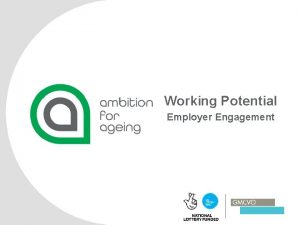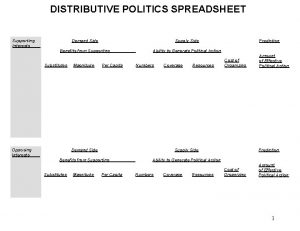Employer Engagement new approaches The demand side of












- Slides: 12

Employer Engagement: new approaches

The demand side of labour market policy 2. 1. The main focus of employment policy has been on the supply side: getting claimants into work Department for Work & Pensions this assumes adequate demand for individual skills or occupation & that matching / vacancy filling is easy/cheap 3. Now recognition that employment policy needs to also focus on matching supply to the demand side of the labour market 2

Vision We want to: • align our business needs to those of employers; • deliver more focused, targeted and efficient services; • improve the employer experience; • improve returns on our key priorities; and • deliver seamless accessibility to our services. Department for Work & Pensions 3

Concept Engagement Description Engagement Outcome Engagement Mechanism Engage employers in the process of finding jobs for claimants Claimants are better matched to vacancies they apply for; employers find it easier to find the right person Matching Engage employers in determining the type of provision of training to the unemployed Claimants are provided with the training in the skills that employers demand, increasing their employability Training Engage employers in the design and delivery of ALMPs By understanding barriers to hiring, the objectives of ALMPs are more efficiently met through collaboration with employers Programmes Engage employers to change attitudes around employing disadvantaged groups By engaging with employers concerns about employing disadvantaged groups can be addressed, increasing the likelihood of their employment Attitudes Department for Work & Pensions 4

Matching: employer engagement holds the prospect of improving outcomes ØMatching is the process in the labour market by which the best possible worker for a job enters a job that is the best possible job for them. ØFor DWP getting matching right means that: 1. Claimants are more likely to enter sustained employment and negates the need for in-work support, and; 2. Employers gain confidence in taking on claimants. ØThe trend in recent years has been toward more claimant-directed search and application, with less of a brokerage role for JCP. Department for Work & Pensions 5

Local Intelligence Common themes: • Growth of industries such as digital technology, retail, financial services, and construction; • A withdrawal of the public sector without a concomitant expansion of private industry; • Cities have in-commuting from outside their borders to fill vacancies; At the same time we still have several issues to address • Many workers are inactive and lack the skills for the market; • An increase in part time jobs and underemployment, with correspondingly low wages; • And a large body of sick and disabled people, highly skilled students working low skill jobs, carers working long hours, and women laid off from public service. Department for Work & Pensions 6

Profiling & Segmentation: questions: • Is the employer part of a demand or growth sector? • Are they a significant or influential employer within their sector? • Do they either offer volumes or a range of vacancies, apprenticeships and other opportunities? • Are they geographically spread across the UK? • Do they have the potential to support hotspot areas with low employment rates? • Are they willing to offer support to our priority group customers? Do they have CSR ambitions that accord with ours? Department for Work & Pensions 7

Delivery We have employer-facing teams with: • loose structures which have grown organically according to local demand • no employer-outcome related objectives, and no orchestrated approaches. • difficulty for employers to reach, even if they wanted to. Ways forward: • A “sales” approach? • Recording and analysing engagement activity • Research into what employer relations actually entails Department for Work & Pensions 8

Metrics Closes the Circle: Issues: • not using insight or feedback from employers and wider stakeholder to inform our approaches and listen to what’s needed. • not using successes in the right way to communicate, and perpetuate success. Ways forward: • using employer feedback and insight on skills, sustained employment, and progression. • Using new data sources available as part of Universal Credit to baseline and measure performance • Take advantage of new, online data sources to indentify which jobs, firms, occupations and sectors are growing Department for Work & Pensions 9

Targets In considering data on employer engagement there are three principal questions that we would like to answer: • Which employers to target for engagement • How and which employers have responded to engagement; and • The additional difference to desired outcomes (e. g. job entries, matching, progression) that engagement delivers. Department for Work & Pensions 10

Early Ideas • Look towards growing industries (digital, retail, financial services), targeting employers with around 50 or more employees • Identify vacancies with skill demands that would ease the transition between sectors • Advertise skills development workshops to local workers, focusing on developing digital and technical skills particularly • Demonstrate adequate support for carers or the disabled/sick who also work, such as flexible working • Target ethnic minorities and women who are overrepresented in the inactive population Department for Work & Pensions 11

Questions?
 Develop new approaches to public governance and engagement
Develop new approaches to public governance and engagement Ways to prove triangles similar
Ways to prove triangles similar Side side side similarity
Side side side similarity Sss similarity definition
Sss similarity definition Aa postulate
Aa postulate Marketing research approaches to demand estimation
Marketing research approaches to demand estimation Perfect competition side by side graphs
Perfect competition side by side graphs Uil side by side
Uil side by side M&a process timeline
M&a process timeline Glass will break first on the weaker side, the side:
Glass will break first on the weaker side, the side: Smtyk
Smtyk Two wheels roll side by side
Two wheels roll side by side Root face
Root face























